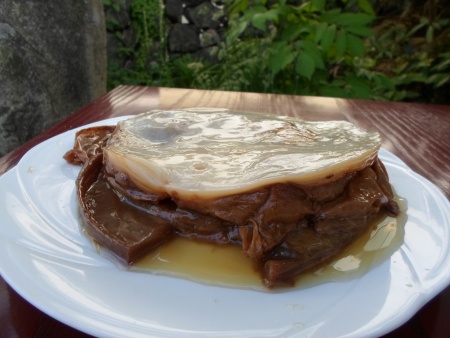Kombucha
Kombucha is a microbial polyculture composed from variety of acetic acid bacteria and yeast species also known under the acronym of SCOBY (symbiotic culture of bacteria and yeast). Traditionally it proliferate by consumption of sugar (for example sucrose/saccharose originating in sugar cane) and black tea dissolved in liquid water medium. This symbiotic complex and especially Gluconacetobacter xylinum is producing microcellulose biofilm which is floating on the top of the brew. White thick compact biofilm generally represents good and healthy culture which stability allows for well flavoured beverage. The biofilm is likely serving as a protection against oxygen from the air and it's floating capacity is due to the absorption of carbon dioxide produced by the microbes in the beverage.
The health benefits of kombucha beverages are widely discussed however scientific evidence supporting the claims is gathering 1. The polyphenols, natural part of the black and green tea are being proven as providing protection against variety of types of cancer and it is shown that they are preserved in the kombucha beverage 2 From personal experience of many consumers they claim direct positive effect on digestion by easing passing the stool, especially after eating heavy fatty meals. Consuming kombucha beverages is considered as ingestion of probiotic microorganisms therefore variety of health benefits subscribed to them applies 3. If the brew is stronger, therefore it's pH is lower people with sensitive tooth should be careful and drink some other beverages to wash their mouths or they tooth may become too sensitive and cause uncomfortable sensations for few hours.
Based on experience the optimal growing temperature for kombucha to obtain beverage of good taste is around 20°C, ranging between 15-25°C (culture grown at temperatures between 10-15°C produce very tasty beverage but takes up to three times of time compared to the 20°C and above). With prolonged temperature above 25°C the brew may become too acidic and the biofilm change it's structure. Hot humid summers in subtropical and definitely tropical regions may be very challenging for working with this culture.
If you would like to brew your own kombucha drink variety of manuals exist, here is for example one used by our group - Kombucha brewing manual - short workshop form.
Literature&Resources
